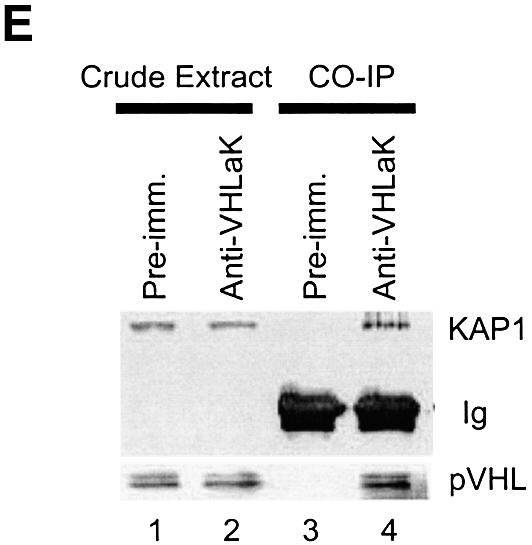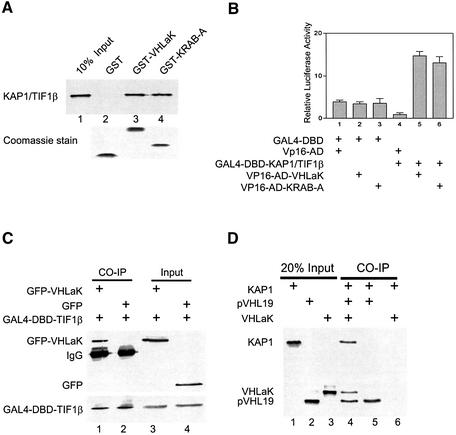
Fig. 6. The VHLaK protein can recruit KAP1/TIF-1β through its KRAB-A domain and both endogenous VHL and KAP1/TIF-1β proteins interact VHLaK simultaneously. (A) Analysis of the interaction between VHLaK and KAP1/TIF-1β by GST pull-down assay. Five microliters of in vitro translated [35S]methionine-labeled KAP1/TIF-1β protein were incubated with GST–VHLaK, GST–KRAB-A or GST-coated beads. The eluted solutions and 10% of input protein were resolved on an 8% SDS–PAGE gel. (B) The interaction between VHLaK and KAP1/TIF-1β in mammalian two-hybrid assay. Lanes 4 and 5, GAL4-DBD-KAP1/TIF-1β and pVP16-VHLaK or pVP16-KRAB-A were co-transfected into COS-7 cells, respectively. Thirty-six hours after transfection, cells were harvested and lysed for luciferase assay. (C) In vivo co-immunoprecipitation of KAP1/TIF-1β with VHLaK. Lysates prepared from COS-7 cells transfected with GAL4-DBD-KAP1/TIF-1β and pEGFP-C3 or pEGFP-C3-VHLaK were subjected to immunoprecipitation (IP) with an anti-GAL4-DBD antibody followed by anti-GFP or anti-GAL4-DBD immunoblotting. (D) Both pVHL and KAP1 can interact with VHLaK simultaneously. VHLaK, pVHL19, and KAP1 were expressed in the presence of [35S]methionine. Co-immunoprecipitation was performed using an anti-VHL antibody. Note that the KAP1 protein can only be co-immunoprecipitated with pVHL in the presence of VHLaK. (E) The endogenous VHLaK protein can recruit endogenous VHL and KAP1 proteins. The top panel shows a western blot analysis of crude extracts (lanes 1 and 2), control immunoprecipitates with the pre-immune serum (lane 3) or immunoprecipitates with anti-VHLaK antibody (lane 4) from HeLa cells immunoblotted with anti-KAP1 antibody; the bottom panel shows similar analysis of same crude extracts and immunoprecipitates immunoblotted with anti-VHL antibody.

